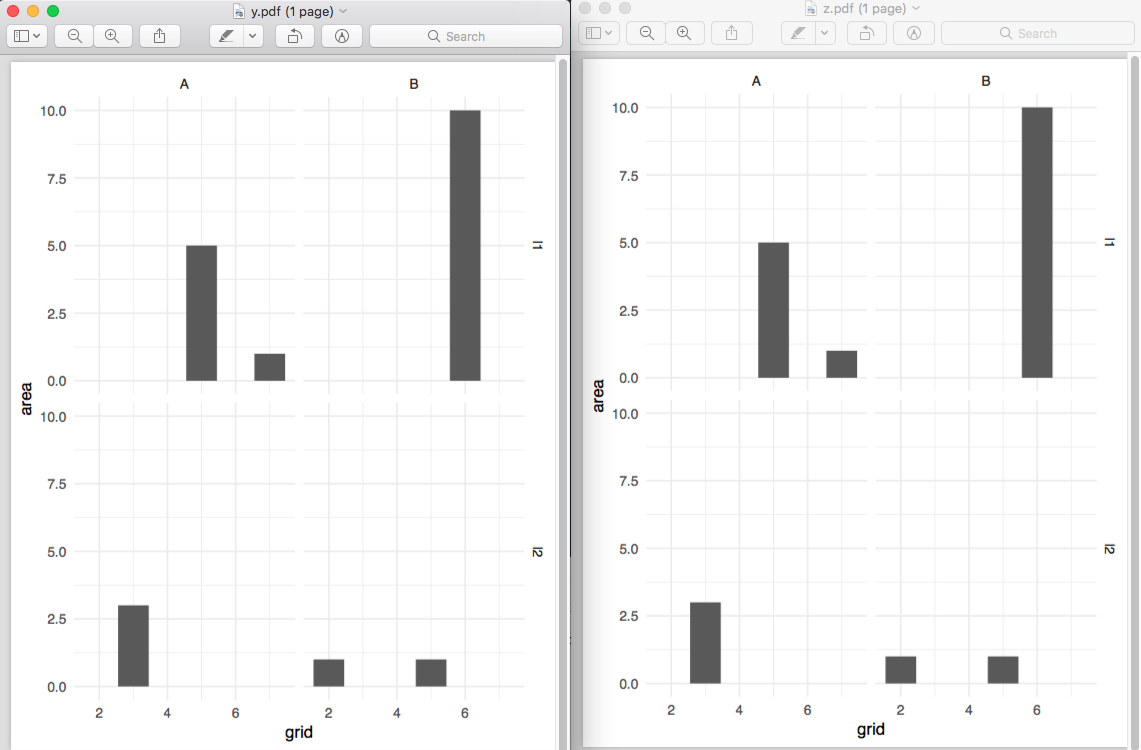我有大约 300 个位于多种山脉类型的站点。我正在尝试制作一些有意义的情节。因此,我想按山脉类型(类型)对我的数据进行子集化,并用 ggplot2 绘制它。我想通过 for 循环或 lapply 来自动化这个过程,但我在这两个方面都是初学者。
我发现了一些使用 for 循环的好例子:http://www.reed.edu/data-at-reed/resources/R/loops_with_ggplot2.html 或使用 lapply:Use for loop in ggplot2 to generate a list
但是,这两种方法都会生成空图。我究竟做错了什么?如何修复我的代码?
# Create dummy data
df<- data.frame(loc = rep(c("l1", "l2"), each = 3),
name = rep(c("A", "B"), 3),
grid = c(5,6,7,2,3,5),
area = c(5,10,1,1,3,1),
areaOrig = rep(c(20, 10, 5), each = 2))
df2<-rbind(df, df)
# Create two mountain types types
df2$type = rep(c("y", "z"), each = 6)
创建函数以生成绘图:
require(ggplot2)
type.graph <- function(df2, na.rm = TRUE, ...) {
# Create list of locations
type_list <-unique(df2$type)
# Create a for loop to produce ggpot plots
for (i in seq_along(type_list)) {
# create a plot for each loc in df
plot<-
windows()
ggplot(subset(df2, df2$type == type_list[i]),
aes(x = grid,
y = area)) +
geom_bar(stat = "identity") +
ggtitle(type_list[i]) +
facet_grid(loc ~name)
print(plot)
}
}
type.graph(df2)
使用lapply 生成绘图:
#significant SNPs
type_list <- unique(df2$type)
#create list of ggplots per type
p_re <-
lapply(type_list, function(i){
ggplot(subset(df2, type == type_list[i]),
aes(x = grid,
y = area)) +
geom_bar(stat = "identity")
})
#assign names
names(p_re) <- type_list
#plot
p_re$y
最佳答案
我建议使用 purrr 包作为 tidyverse 的一部分,通过分组因子嵌套数据框,然后遍历子集数据。下面是一个例子:
library(tidyverse)
by_type <- df2 %>%
group_by(type) %>%
nest() %>%
mutate(plot = map(data,
~ggplot(. ,aes(x = grid, y = area)) +
geom_bar(stat = "identity") +
ggtitle(.) +
facet_grid(loc ~name)))
by_type
# A tibble: 2 x 3
type data plot
<chr> <list> <list>
1 y <tibble [6 × 5]> <S3: gg>
2 z <tibble [6 × 5]> <S3: gg>
上面给出了一个普通的数据框,但数据和绘图列是列表列。因此,第一个数据“单元格”包含 type == y 的所有数据,第二个包含 type == z 的所有数据。此基本结构由 tidyr::nest 创建。然后,您通过使用 purrr::map 遍历数据列表列来创建一个新变量,我称之为 plot,您只需将数据参数替换为 。。请注意,map2 和 pmap 函数适用于您希望一次遍历多个事物(例如,如果您希望标题不同。
然后您可以使用 by_type$plot 轻松查看您的数据,或使用
walk2(by_type$type, by_type$plot,
~ggsave(paste0(.x, ".pdf"), .y))
关于r - 通过 for 循环/lappy 对数据进行子集化和绘图,我们在Stack Overflow上找到一个类似的问题: https://stackoverflow.com/questions/48527446/
